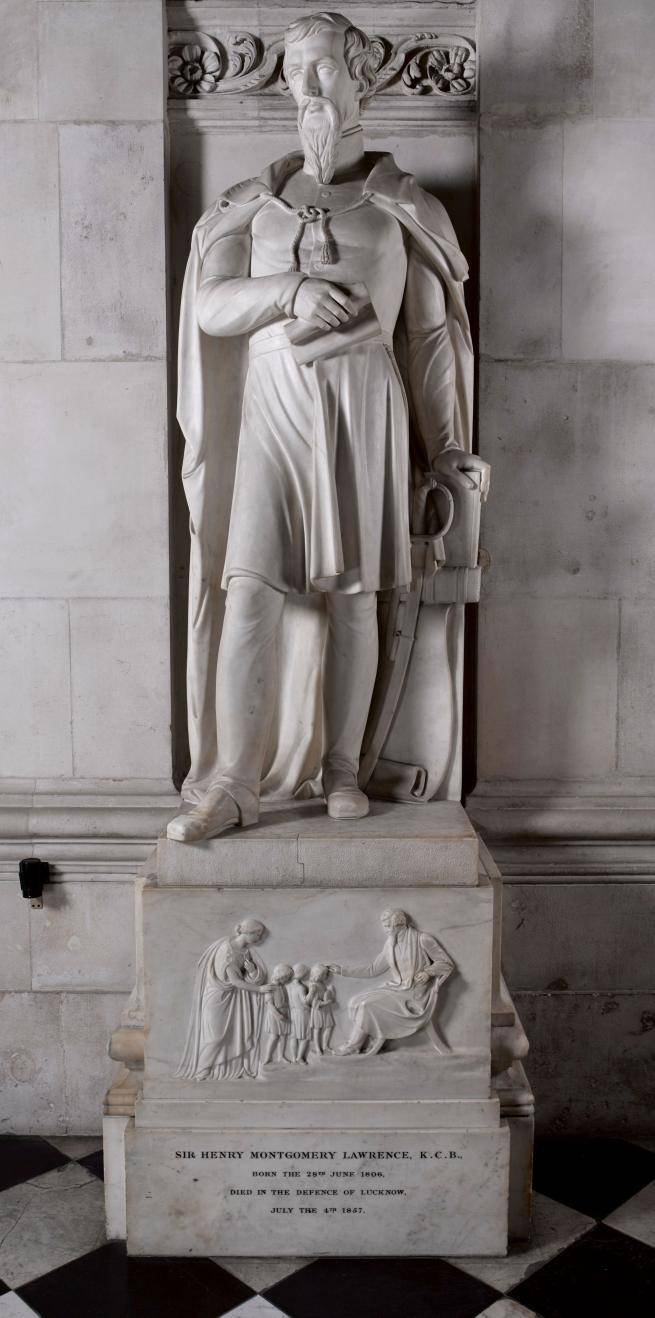Sir Henry Montgomery Lawrence (1806-57)

Image courtesy of Pantheons: Sculpture at St Paul's Cathedral.
Sir Henry Montgomery Lawrence
1806-57
This work is part of The East India Company at St Paul’s: A digital trail produced in collaboration with Stepney Community Trust.
Written by Ricky Singh Ahluwalia, writer on Indian colonial history, whose ongoing research was ignited by the discovery that his great grandfather, Khushal Singh, was the personal assistant to Maharaja Jagatjit Singh of Kapurthala.
The following text is available in Bengali, Gujurati, Urdu, Hindi, Punjabi, and Tamil. Please email CollectionsDepartment@stpaulscathedral.org.uk to request a copy.
Sir Henry Lawrence is associated with the conquest of the Punjab, an independent kingdom resisting East India Company rule until 1849. From 1839, Lawrence was involved in various capacities with ‘Punjab affairs’ and in 1842, he led a regime of troops lent by the then-independent Sikh ruler in the first Anglo-Afghan War. He was appointed ‘resident’ or ambassador to the Punjab kingdom in 1846, after the first Anglo-Sikh War, which hugely reduced territories of the kingdom, and practically subordinated the Punjab to the East India Company. Appointed ‘resident’ or ambassador to this semi-conquered kingdom, Lawrence began acting as its ruler, and worked especially to reduce the power of the Queen-regent, Maharani Jind Kaur. Although Lawrence was personally opposed to the outright conquest of the Punjab, after the second Anglo-Sikh War in 1849, he was put in charge as the President of the Board of Administration of the Punjab, a post he held until 1853. However, Lawrence was found less amenable to East India Company aims, and was replaced by his more hawkish brother, John Lawrence. Henry Lawrence moved on to other posts, including Awadh - another independent princely state, taken over by the East India Company in 1856. It is here, in the city of Lucknow, that Lawrence was killed by Indian rebels in 1857. After this revolt against the East India Company, the British Crown took over the administration of India. The 'Jewel in the Crown' remained under British rule for almost another 100 years, until its eventual independence and partition in 1947.
Lawrence is also remembered for establishing the Lawrence Charitable Schools of India, though only for Christian children of British soldiers, orphaned European children, and the so-called ‘poor whites' living in India. His role as an educator is depicted at the bottom of the monument, as he 'blesses’ selected children with an education in British learning and etiquette. Considered a virtuous man by many, he did nevertheless carry out some questionable political actions. He helped create the still-disputed region of Kashmir by orchestrating its sale to Gulab Singh under the Treaty of Amritsar in 1846. With guidance from Lord Dalhousie and Henry Hardinge, Lawrence helped systematically dismantle the Sikh Empire, and after two Anglo-Sikh Wars, the East India Company took control of the Punjab. Lawrence helped depose the now powerless, child Maharaja Duleep Singh (son of Maharaja Ranjit Singh) and exiled him to England, imprisoned his mother Maharani Jind Kaur, appointed John Spencer Login to be his guardian in her place, encouraged his conversion to Christianity and exhorted the eleven-year-old Duleep Singh to hand over the Kohinoor Diamond to Queen Victoria.
Men such as Lawrence did their duty and acted for the perceived good of the Crown, expanding its territories, supporting Christian missionary activity, and ultimately feeding the insatiable financial appetite of the East India Company (and later the British State). They acted in conformity to the norms and habits of British society at that time, embodying values summed up in Rudyard Kipling’s poem ‘The White Man’s Burden'. However, if today we were to commission a new monument for St Paul's, I doubt it would be to a person whose actions further these types of interests. I believe the world we inhabit today is different from the days of direct colonialism, with its imperialist ideologies that Sir Henry Lawrence, and the institutions he represented, held dear. Personally, I feel that an unanticipated and ironic consequence of the British Empire occupying vast territories around the globe, and trying to reshape those cultures into its own light, is that today, Britain itself and its values have melded into a kaleidoscope of colours, heritage and shared futures.
For detailed information about this monument, visit the Pantheons: Sculpture at St Paul's Cathedral website.

The East India Company at St Paul's
Explore the full digital trail produced in collaboration with Stepney Community Trust.




